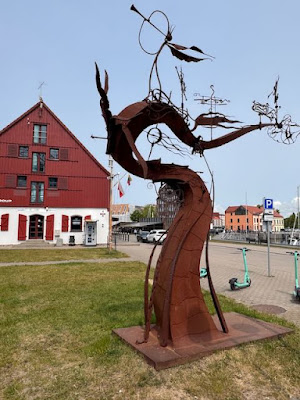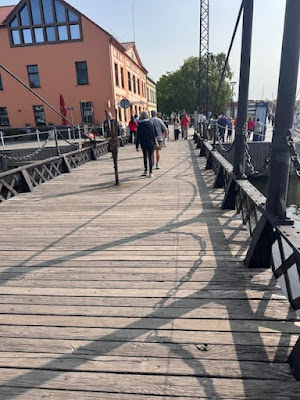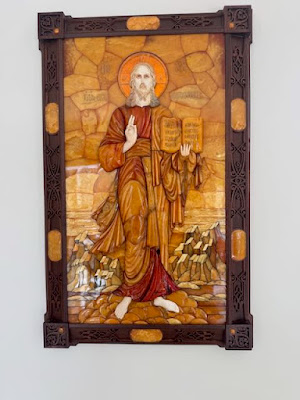Klaipeda is an ice-free port on the coast of Lithuania along the Baltic Sea. It is the third largest city in that country. The city was known as Memel from 1252 to 1945.
A group of younger people in native costumes greeted us with 'German' music as we disembarked for our time in Klaipeda.
We crossed the swing bridge (built in 1855) to find our first geocache and to begin a tour of art and statues in the city.
This was a puzzle cache. I gave the information to OFD at breakfast, suggesting she solve it for our first cache find in Lithuania. She did! (I could have solved it, but not as quickly as she did!)
the geocaching souvenir
Black Ghost greeted us at the swing bridge
The bronze sculpture, known as "Juodasis Vaiduoklis" ("The Black Ghost") has been terrifying children since 2010. Sculpted by Svajunas Jurkus and Sergejus Plotnikovas, the figure is 7.8 feet in height, with about half below the level of the waterfront walkway and half above. Apart from the ghost’s hands, the hooded robe is empty inside, creating a strangely expressive spectral appearance despite the lack of any facial features. ~ Atlas Obscura

The Black Ghost is tied to a local legend that isn’t quite as terrifying as you would imagine. The legend dates back to 1595, when Hans von Heidi, one of the guards at Klaipėda Castle, was doing his nightly rounds near the harbor. From out of nowhere, a hooded figure appeared near the water’s edge. Rather than attack the startled guard, it asked him how the city’s supplies of grain and timber were holding out. Von Heidi informed the ghost that the city had sufficient supplies, but the ghost warned him it would not be enough. At that point, the apparition vanished. Back in the good old days, of course, people were inclined to believe the words of ghosts, witches, goblins, and giants. And so Hans von Heidi dutifully informed his superiors of his ghostly encounter, and the city set about increasing its supplies of timber and grain. Then followed a bleak few years of hunger and shortage, which the people of Klaipėda only survived because of the ghost’s warning. ~ Atlas Obscura

That was the beginning of finding 5 specific sculptures in the town to complete a geocaching Adventure Lab.
This is some of the other interesting things we saw while looking for Klaipeda sculptures.
colorful homes
mural at a sidewalk cafe
darling little booths at another sidewalk cafe location
Other sculptures that were not part of the geocaching hunt. (The Little Mouse was on OFD's "must find" list at this cruise stop.
Klaipeda is known for its amber. Amber was the shopping goal! We did not purchase any in this store/museum, but it was fun to look. It was interesting to see the amber pieces with embedded insects.
amber colors: Green, Red, Yellow, Blue, Brown, Orange
Amber is a fossilized tree resin, prized for its beauty and used in jewelry and decorative objects. It's also known for potentially containing ancient insects and plant matter, making it a valuable resource for scientific study. Additionally, amber has been associated with various cultural and medicinal beliefs throughout history. ~ AI Overview
The port cities of Riga, Klaipeda, and Gdansk are part of the Baltic Sea amber region.
pieces of amber glass
It was Sunday when we stopped in Klaipeda. There were craft tents along the perimeter of the square where this statue (fountain built in 1912) was located. We added to the economy of the local craftsman!
Memel Castle/ Klaipeda Castle
The Castle of Klaipėda, also known as Memelburg or Memel Castle, was built by the Livonian (Teutonic) Order at the mouth of the Dangė River. The castle was first mentioned in written sources in 1252. Centuries of fights between Lithuanians and Germans followed. ~ Visit Castles
a geocache find at the castle
cute little treasure chest with a cute story about hidden treasure
wind vane sculptures near the port



Ever since the old times, people from nearby or more remote villages went to Klaipeda market, just as the fishermen of the Curonian Lagoon did to sell their catch. The fishermen's sailing boats moored in the city centre: on the River Dane or in the small harbour next to the castle, so townspeople were used to seeing the weathervanes on boat masts already at the end of the 19th century. The ingeniously-cut multicoloured weathervanes were also called flags (German Flagge) or coats of arms (German Wappen).
The origins of weathervanes, the element of mast decoration, are related to fishing regulations on the Curonian Lagoon: the decree of 7 June 1844 of the authorities obliged every fisherman who had a fishing right to raise a two-foot by one-foot (approx. 62X31 cm) flag of corresponding colour combination of the region on the boat mast (H.Woede, p.51). The chief fishing supervisor (German Oberfischmeister), appointed by the authorities, former burgomaster of Klaipeda Ernst Wilhelm Beerbohm (1786-1865), in implementing the said decree, created a distinctive sign for each settlement on the seacoast composed of a geometric figure with a different colour combination (white and red for fishing villages of the eastern coast of the lagoon, blue and yellow for the southern coast, and white and black for the western). This facilitated identification of fishermen's boats for Beerbohm and his followers when controlling fishing on the Curonian Lagoon. ~ From signange at this weathervane display near the harbor
Next: Gdańsk, Poland


























No comments:
Post a Comment
Thanks for your comments!